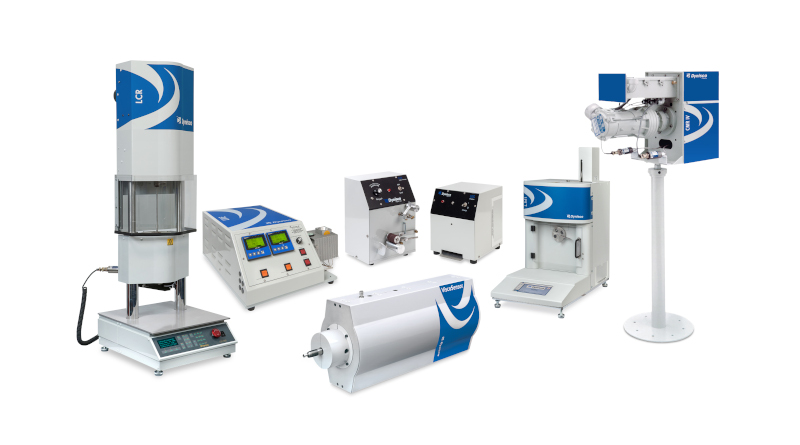Inline viscosity measurement
PET and polyolefin recycling
by Heike Fischer

Polymer manufacturers need to create new materials and deliver high quality to meet ever changing end-use requirements. Precise testing and analysis are mandatory to ensure quality and to stay competitive. Dynisco analysers, including melt flow indexers, and rheometers, are well-known for testing the properties of polymers. Material analysis solutions range from the analysis of a polymer in the laboratory, to online quality control in production, to processing small quantities of special polymers or composites. At the Plastics Recycling World Expo, PETplanet spoke to Johannes Lorenz, Sales Manager at Dynisco, about inline viscosity measurement in PET and polyolefin recycling.
PETplanet: In your opinion, what are the advantages for testing the rheology of thermoplastic polymers compared to other methods?
Lorenz: Rheometers or viscosi-meters are a relatively inexpensive and quick way to determine flow properties which are essential to design or set-up manufacturing processes for plastics. The simplest viscosity measuring device is a melt flow indexer which can be found in almost every company converting or manufacturing plastics or plastic goods.
PETplanet: Would you please briefly explain the traditional offline Capillary Rheometer measurement process?
Lorenz: In a typical setup, polymer is molten inside a heated cell or container, normally cylindrical, and forced by means of a piston through an orifice with specific dimensions. This can be done by simply putting a weight on that piston that would push the molten polymer through the orifice. In other methods the piston is operated by a drive that can apply either a constant load or a constant or controlled speed to the polymer melt. Characteristic properties like MFR (MVR) or viscosity can be calculated directly from the test parameters and resulting measurements (speed, force).
PETplanet: You have now translated this process into an online system. How is it basically structured?
Lorenz: The main goal here is to have a continuous measurement that provides real-time viscosity data. We are still using an orifice (or capillary) through which the polymer is pushed through. Instead of a piston, we are using a gear pump to convey a side stream from the main extrusion stream of polymer through a heated flow block and the capillary. This allows us to apply similar techniques as described above. Either the system operates at a constant pressure which in turn gives data like MFR or MVR or the system is operated at a controlled speed which allows to calculate shear viscosity from the data. Usually thermal or geometric corrections are applied to compare these data with numbers derived from lab tests. Typically, the comparison is very good so you not only have a real-time process overview but potentially could save a lot of lab time by implementing such systems in your production.
PETplanet: You presented two types of rheometers, the Continuous Melt Rheometers (CMR IV) and the Zero Discharge Rheometers – ViscoSensor. How do they work?
Lorenz: There are mainly two types of instruments: a CMR IV is an open system where the measured melt stream goes through the system (pump – flow block – capillary) and then exits the system. This small stream of polymer is then discarded but could also be used for subsequent verification. The ViscoSensor in turn is a closed-loop, return stream system. The measuring stream is being pushed through the capillary but subsequently is fed back to the main process (pump 1– flow block – capillary – flow block – pump 2). Both systems have advantages and disadvantages depending on the application.
PETplanet: What about rPET applications?
Lorenz: These systems are commonly used along the whole value chain from resin production over conversion into e.g. film, sheet, compounds and in mechanical or chemical recycling. The very typical scenario for us is rPET. Making pellets from flakes or other recycled sources is a very common application for our systems. A real-time continuous viscosity measurement can help to accurately determine the quality of PET pellets which is critical for all subsequent steps in the production process. Deviations in the production process and the product quality can quickly be identified and measures can be taken to keep the consequences minimal. Furthermore, our systems provide a correlation between melt viscosity and IV (intrinsic viscosity). IV has the same importance in the PET world as MFR or MVR would have with plastics like PE, PP, PS,… Knowing the IV right away can be important in time critical value chains. Lot-to-lot variation can be kept to a minimum or eliminated entirely. Furthermore, lab utilisation can be reduced.
PETplanet: Do you already have systems in the rPET market? What is the feedback?
Lorenz: We have numerous systems in use at recyclers, film and sheet manufacturers and integrated flake-to-product operations (bottles, film, foam, fiber). Everywhere, where IV is a critical parameter (hence everywhere) and the more detailed this information can be provided there is always benefit in using this kind of system. Specifications can be narrowed down, stock can be easily sorted and classified, incoming stock (e.g. flakes) can be utilised better and lab work can be reduced only to name a few benefits.
PETplanet: Thank you very much.


